air condition Hyundai Elantra 2018 Owner's Manual
[x] Cancel search | Manufacturer: HYUNDAI, Model Year: 2018, Model line: Elantra, Model: Hyundai Elantra 2018Pages: 526, PDF Size: 17.2 MB
Page 18 of 526
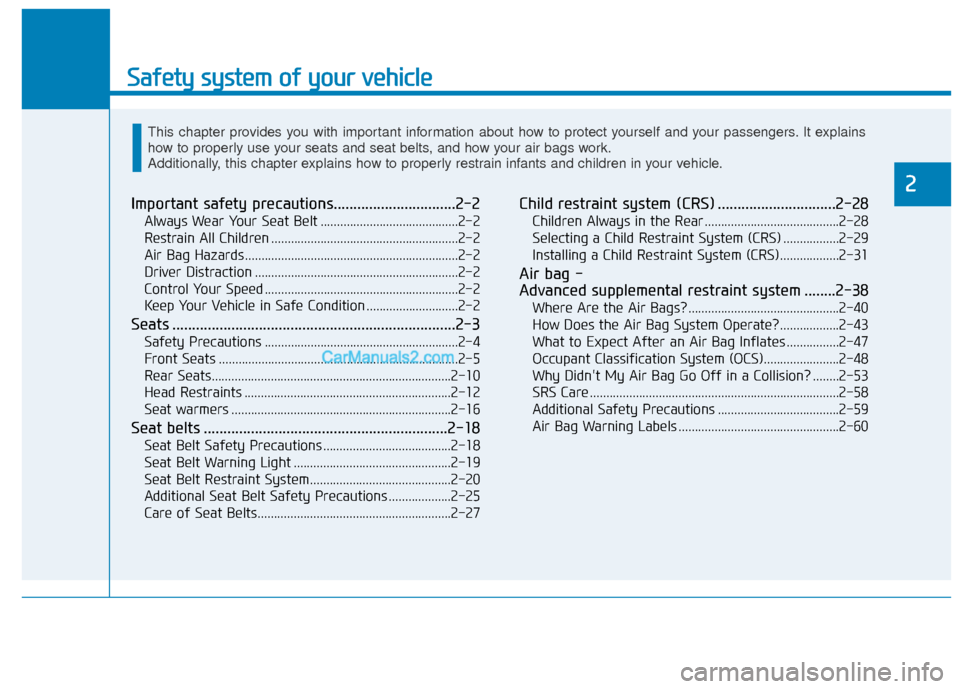
Safety system of your vehicle
Important safety precautions...............................2-2
Always Wear Your Seat Belt ..........................................2-2
Restrain All Children .........................................................2-2
Air Bag Hazards .................................................................2-2
Driver Distraction ..............................................................2-2
Control Your Speed ...........................................................2-2
Keep Your Vehicle in Safe Condition ............................2-2
Seats ........................................................................\
2-3
Safety Precautions ...........................................................2-4
Front Seats ........................................................................\
.2-5
Rear Seats........................................................................\
.2-10
Head Restraints ...............................................................2-12
Seat warmers ...................................................................2-16
Seat belts ..............................................................2-18
Seat Belt Safety Precautions .......................................2-18
Seat Belt Warning Light ................................................2-19
Seat Belt Restraint System...........................................2-20
Additional Seat Belt Safety Precautions ...................2-25
Care of Seat Belts...........................................................2-27
Child restraint system (CRS) ..............................2-28
Children Always in the Rear .........................................2-28
Selecting a Child Restraint System (CRS) .................2-29
Installing a Child Restraint System (CRS)..................2-31
Air bag -
Advanced supplemental restraint system ........2-38
Where Are the Air Bags? ..............................................2-40
How Does the Air Bag System Operate?..................2-43
What to Expect After an Air Bag Inflates ................2-47
Occupant Classification System (OCS).......................2-48
Why Didn't My Air Bag Go Off in a Collision? ........2-53
SRS Care ........................................................................\
....2-58
Additional Safety Precautions .....................................2-59
Air Bag Warning Labels .................................................2-60
This chapter provides you with important information about how to protect yourself and your passengers. It explains
how to properly use your seats and seat belts, and how your air bags work.
Additionally, this chapter explains how to properly restrain infants and children in your vehicle.
2
Page 19 of 526
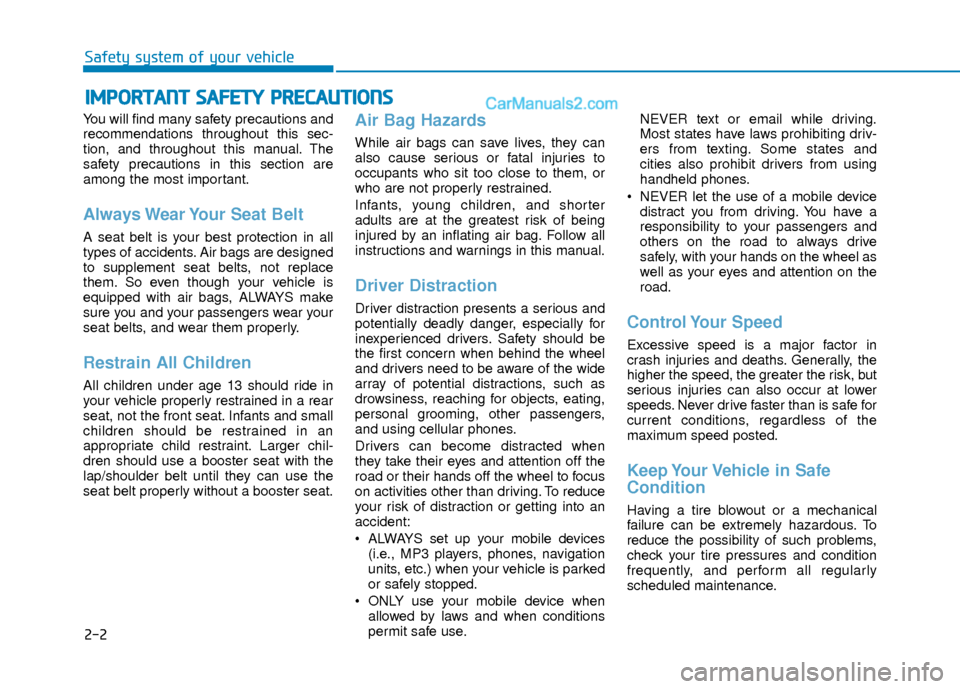
2-2
You will find many safety precautions and
recommendations throughout this sec-
tion, and throughout this manual. The
safety precautions in this section are
among the most important.
Always Wear Your Seat Belt
A seat belt is your best protection in all
types of accidents. Air bags are designed
to supplement seat belts, not replace
them. So even though your vehicle is
equipped with air bags, ALWAYS make
sure you and your passengers wear your
seat belts, and wear them properly.
Restrain All Children
All children under age 13 should ride in
your vehicle properly restrained in a rear
seat, not the front seat. Infants and small
children should be restrained in an
appropriate child restraint. Larger chil-
dren should use a booster seat with the
lap/shoulder belt until they can use the
seat belt properly without a booster seat.
Air Bag Hazards
While air bags can save lives, they can
also cause serious or fatal injuries to
occupants who sit too close to them, or
who are not properly restrained.
Infants, young children, and shorter
adults are at the greatest risk of being
injured by an inflating air bag. Follow all
instructions and warnings in this manual.
Driver Distraction
Driver distraction presents a serious and
potentially deadly danger, especially for
inexperienced drivers. Safety should be
the first concern when behind the wheel
and drivers need to be aware of the wide
array of potential distractions, such as
drowsiness, reaching for objects, eating,
personal grooming, other passengers,
and using cellular phones.
Drivers can become distracted when
they take their eyes and attention off the
road or their hands off the wheel to focus
on activities other than driving. To reduce
your risk of distraction or getting into an
accident:
• ALWAYS set up your mobile devices
(i.e., MP3 players, phones, navigation
units, etc.) when your vehicle is parked
or safely stopped.
ONLY use your mobile device when allowed by laws and when conditions
permit safe use. NEVER text or email while driving.
Most states have laws prohibiting driv-
ers from texting. Some states and
cities also prohibit drivers from using
handheld phones.
NEVER let the use of a mobile device distract you from driving. You have a
responsibility to your passengers and
others on the road to always drive
safely, with your hands on the wheel as
well as your eyes and attention on the
road.Control Your Speed
Excessive speed is a major factor in
crash injuries and deaths. Generally, the
higher the speed, the greater the risk, but
serious injuries can also occur at lower
speeds. Never drive faster than is safe for
current conditions, regardless of the
maximum speed posted.
Keep Your Vehicle in Safe
Condition
Having a tire blowout or a mechanical
failure can be extremely hazardous. To
reduce the possibility of such problems,
check your tire pressures and condition
frequently, and perform all regularly
scheduled maintenance.
I IM
M P
PO
O R
RT
TA
A N
N T
T
S
S A
A F
FE
E T
T Y
Y
P
P R
R E
EC
CA
A U
U T
TI
IO
O N
NS
S
Safety system of your vehicle
Page 52 of 526
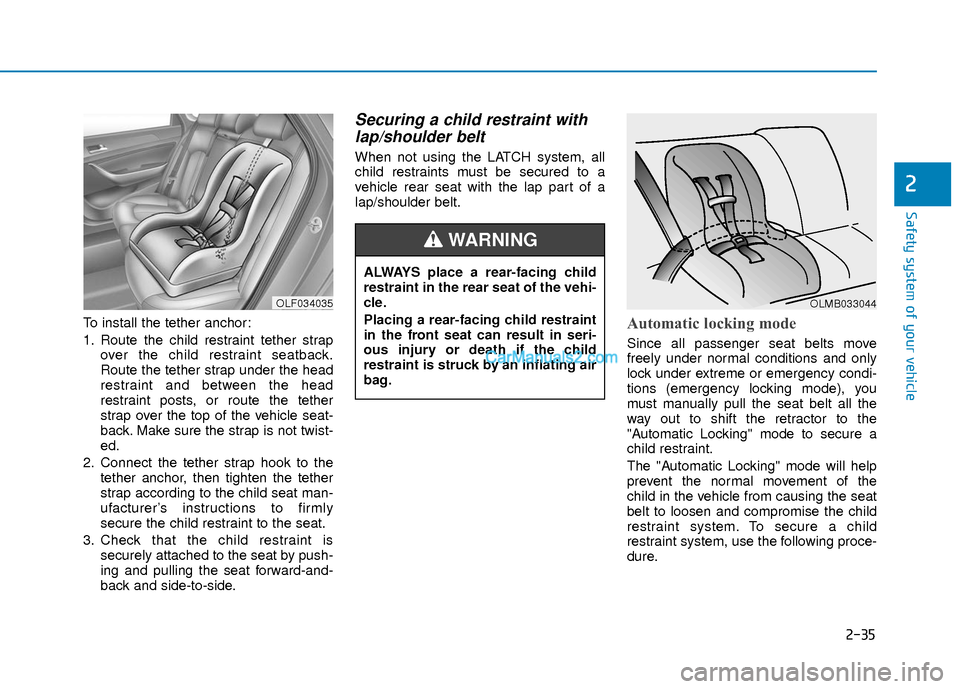
2-35
Safety system of your vehicle
2
To install the tether anchor:
1. Route the child restraint tether strapover the child restraint seatback.
Route the tether strap under the head
restraint and between the head
restraint posts, or route the tether
strap over the top of the vehicle seat-
back. Make sure the strap is not twist-
ed.
2. Connect the tether strap hook to the tether anchor, then tighten the tether
strap according to the child seat man-
ufacturer’s instructions to firmly
secure the child restraint to the seat.
3. Check that the child restraint is securely attached to the seat by push-
ing and pulling the seat forward-and-
back and side-to-side.
Securing a child restraint withlap/shoulder belt
When not using the LATCH system, all
child restraints must be secured to a
vehicle rear seat with the lap part of a
lap/shoulder belt.
Automatic locking mode
Since all passenger seat belts move
freely under normal conditions and only
lock under extreme or emergency condi-
tions (emergency locking mode), you
must manually pull the seat belt all the
way out to shift the retractor to the
"Automatic Locking" mode to secure a
child restraint.
The "Automatic Locking" mode will help
prevent the normal movement of the
child in the vehicle from causing the seat
belt to loosen and compromise the child
restraint system. To secure a child
restraint system, use the following proce-
dure.
OLF034035
ALWAYS place a rear-facing child
restraint in the rear seat of the vehi-
cle.
Placing a rear-facing child restraint
in the front seat can result in seri-
ous injury or death if the child
restraint is struck by an inflating air
bag.
WARNING
OLMB033044
Page 61 of 526
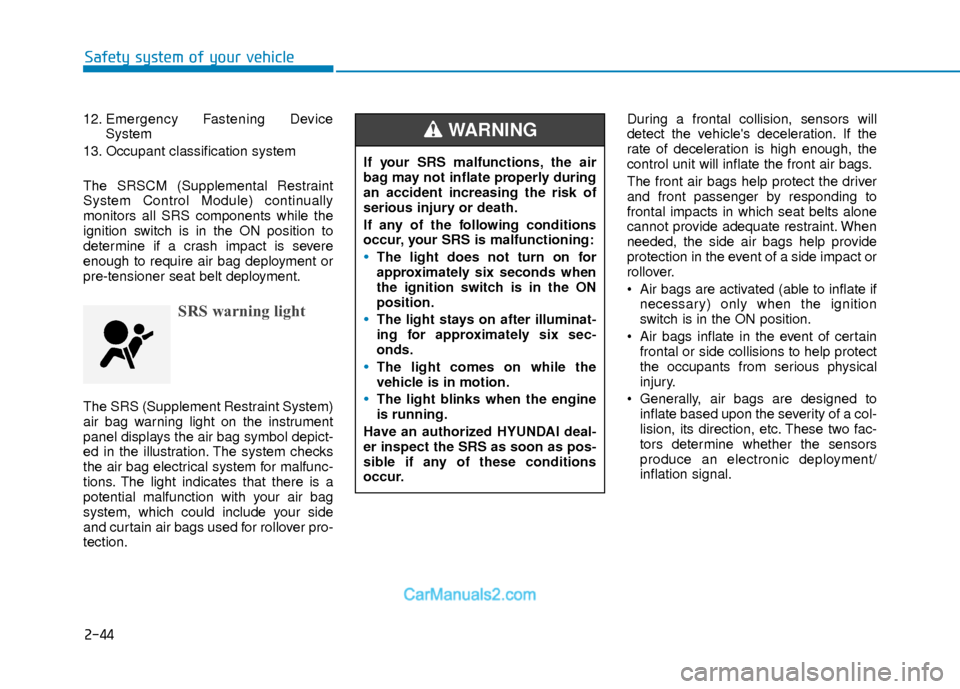
2-44
Safety system of your vehicle
12. Emergency Fastening DeviceSystem
13. Occupant classification system
The SRSCM (Supplemental Restraint
System Control Module) continually
monitors all SRS components while the
ignition switch is in the ON position to
determine if a crash impact is severe
enough to require air bag deployment or
pre-tensioner seat belt deployment.
SRS warning light
The SRS (Supplement Restraint System)
air bag warning light on the instrument
panel displays the air bag symbol depict-
ed in the illustration. The system checks
the air bag electrical system for malfunc-
tions. The light indicates that there is a
potential malfunction with your air bag
system, which could include your side
and curtain air bags used for rollover pro-
tection. During a frontal collision, sensors will
detect the vehicle's deceleration. If the
rate of deceleration is high enough, the
control unit will inflate the front air bags.
The front air bags help protect the driver
and front passenger by responding to
frontal impacts in which seat belts alone
cannot provide adequate restraint. When
needed, the side air bags help provide
protection in the event of a side impact or
rollover.
Air bags are activated (able to inflate if
necessary) only when the ignition
switch is in the ON position.
Air bags inflate in the event of certain frontal or side collisions to help protect
the occupants from serious physical
injury.
Generally, air bags are designed to inflate based upon the severity of a col-
lision, its direction, etc. These two fac-
tors determine whether the sensors
produce an electronic deployment/
inflation signal.
If your SRS malfunctions, the air
bag may not inflate properly during
an accident increasing the risk of
serious injury or death.
If any of the following conditions
occur, your SRS is malfunctioning:
The light does not turn on for
approximately six seconds when
the ignition switch is in the ON
position.
The light stays on after illuminat-
ing for approximately six sec-
onds.
The light comes on while the
vehicle is in motion.
The light blinks when the engine
is running.
Have an authorized HYUNDAI deal-
er inspect the SRS as soon as pos-
sible if any of these conditions
occur.
WARNING
Page 65 of 526
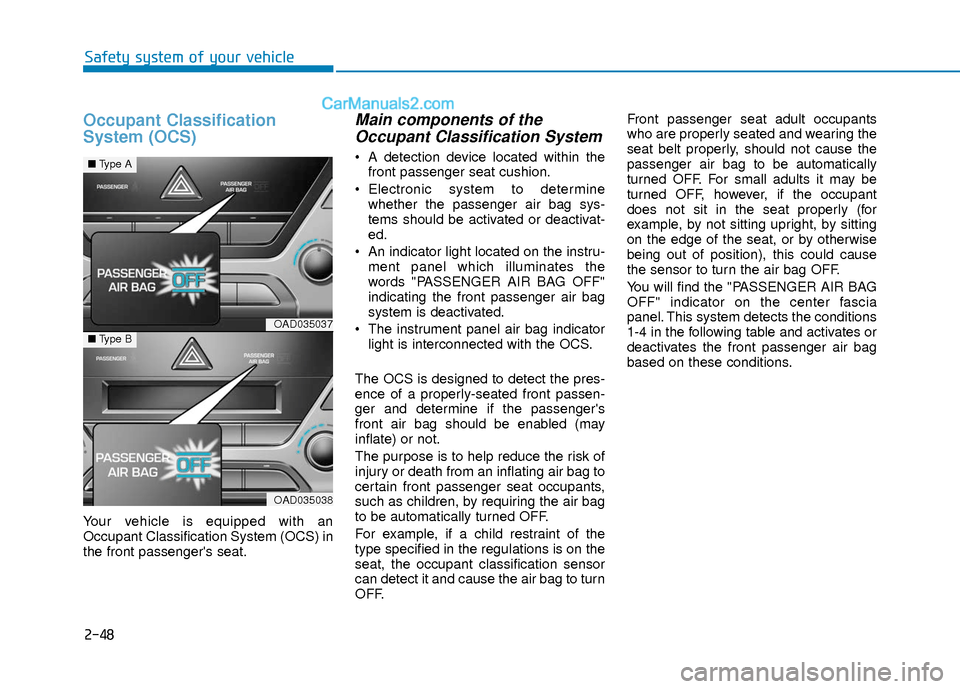
2-48
Safety system of your vehicle
Occupant Classification
System (OCS)
Your vehicle is equipped with an
Occupant Classification System (OCS) in
the front passenger's seat.
Main components of theOccupant Classification System
A detection device located within the
front passenger seat cushion.
Electronic system to determine whether the passenger air bag sys-
tems should be activated or deactivat-
ed.
An indicator light located on the instru- ment panel which illuminates the
words "PASSENGER AIR BAG OFF"
indicating the front passenger air bag
system is deactivated.
The instrument panel air bag indicator light is interconnected with the OCS.
The OCS is designed to detect the pres-
ence of a properly-seated front passen-
ger and determine if the passenger's
front air bag should be enabled (may
inflate) or not.
The purpose is to help reduce the risk of
injury or death from an inflating air bag to
certain front passenger seat occupants,
such as children, by requiring the air bag
to be automatically turned OFF.
For example, if a child restraint of the
type specified in the regulations is on the
seat, the occupant classification sensor
can detect it and cause the air bag to turn
OFF. Front passenger seat adult occupants
who are properly seated and wearing the
seat belt properly, should not cause the
passenger air bag to be automatically
turned OFF. For small adults it may be
turned OFF, however, if the occupant
does not sit in the seat properly (for
example, by not sitting upright, by sitting
on the edge of the seat, or by otherwise
being out of position), this could cause
the sensor to turn the air bag OFF.
You will find the "PASSENGER AIR BAG
OFF" indicator on the center fascia
panel. This system detects the conditions
1-4 in the following table and activates or
deactivates the front passenger air bag
based on these conditions.
OAD035037
OAD035038
■
Type A
■Type B
Page 66 of 526
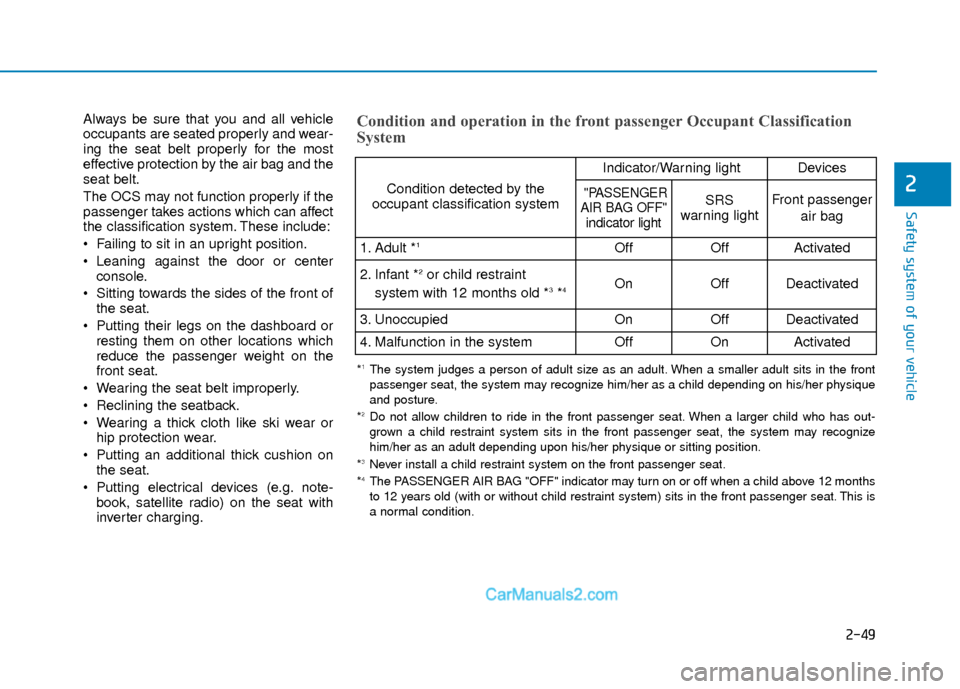
2-49
Safety system of your vehicle
2
Always be sure that you and all vehicle
occupants are seated properly and wear-
ing the seat belt properly for the most
effective protection by the air bag and the
seat belt.
The OCS may not function properly if the
passenger takes actions which can affect
the classification system. These include:
Failing to sit in an upright position.
Leaning against the door or centerconsole.
Sitting towards the sides of the front of the seat.
Putting their legs on the dashboard or resting them on other locations which
reduce the passenger weight on the
front seat.
Wearing the seat belt improperly.
Reclining the seatback.
Wearing a thick cloth like ski wear or hip protection wear.
Putting an additional thick cushion on the seat.
Putting electrical devices (e.g. note- book, satellite radio) on the seat with
inverter charging.Condition and operation in the front passenger Occupant Classification
System
Condition detected by the
occupant classification system
Indicator/Warning lightDevices
"PASSENGER
AIR BAG OFF" indicator lightSRS
warning lightFront passenger
air bag
1. Adult *1OffOffActivated
2. Infant *2or child restraint
system with 12 months old *3*4 OnOffDeactivated
3. Unoccupied OnOffDeactivated
4. Malfunction in the systemOffOnActivated
*1The system judges a person of adult size as an adult. When a smaller adult sits in the front
passenger seat, the system may recognize him/her as a child depending on his/her physique
and posture.
*
2Do not allow children to ride in the front passenger seat. When a larger child who has out- grown a child restraint system sits in the front passenger seat, the system may recognize
him/her as an adult depending upon his/her physique or sitting position.
*
3Never install a child restraint system on the front passenger seat.
*4The PASSENGER AIR BAG "OFF" indicator may turn on or off when a child above 12 months
to 12 years old (with or without child restraint system) sits in the front passenger seat. This is
a normal condition.
Page 72 of 526

2-55
Safety system of your vehicle
2
Air bag inflation conditions
Front air bags
Front air bags and the driver’s knee air
bag are designed to inflate in a frontal
collision depending on the the severity of
impact of the front collision.
Side and curtain air bags
Side and curtain air bags are designed to
inflate when an impact is detected by
side collision sensors depending on the
severity of impact resulting from a side
impact collision.Although the driver’s and front passen-
ger’s air bags are designed to inflate only
in frontal collisions, they also may inflate
in other types of collisions if the front
impact sensors detect a sufficient
impact. Side and curtain air bags are
designed to inflate only in side impact
collisions or rollover situations, but they
may inflate in other collisions if the side
impact sensors detect a sufficient
impact.
If the vehicle chassis is impacted by
bumps or objects on unimproved roads,
the air bags may deploy. Drive carefully
on unimproved roads or on surfaces not
designed for vehicle traffic to prevent
unintended air bag deployment.
OLF034050
OAD035045
OAD035046
Page 73 of 526
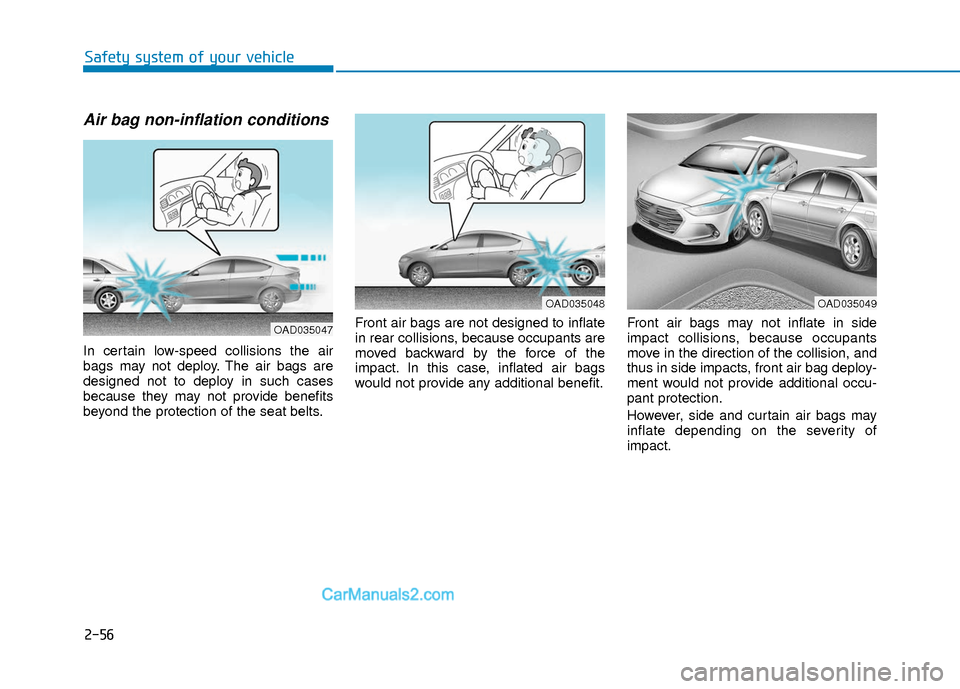
2-56
Safety system of your vehicle
Air bag non-inflation conditions
In certain low-speed collisions the air
bags may not deploy. The air bags are
designed not to deploy in such cases
because they may not provide benefits
beyond the protection of the seat belts.Front air bags are not designed to inflate
in rear collisions, because occupants are
moved backward by the force of the
impact. In this case, inflated air bags
would not provide any additional benefit.
Front air bags may not inflate in side
impact collisions, because occupants
move in the direction of the collision, and
thus in side impacts, front air bag deploy-
ment would not provide additional occu-
pant protection.
However, side and curtain air bags may
inflate depending on the severity of
impact.
OAD035049OAD035048
OAD035047
Page 79 of 526
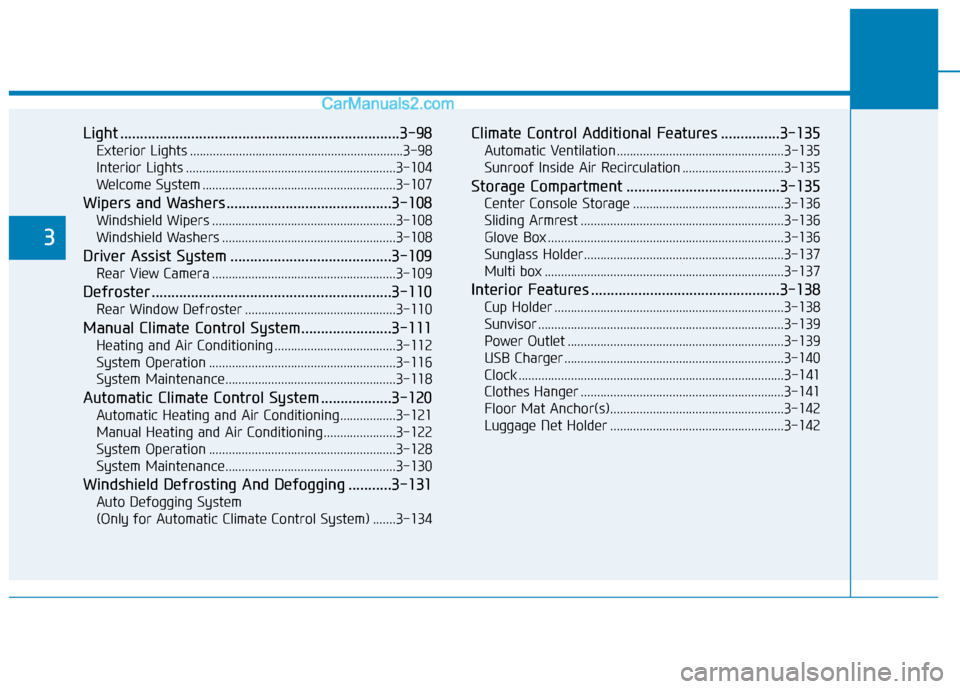
Light .......................................................................3\
-98
Exterior Lights .................................................................3-98
Interior Lights ................................................................3-104
Welcome System ...........................................................3-107
Wipers and Washers..........................................3-108
Windshield Wipers ........................................................3-108
Windshield Washers .....................................................3-108
Driver Assist System .........................................3-109
Rear View Camera ........................................................3-109
Defroster .............................................................3-110
Rear Window Defroster ..............................................3-110
Manual Climate Control System.......................3-111
Heating and Air Conditioning .....................................3-112
System Operation .........................................................3-116
System Maintenance....................................................3-118
Automatic Climate Control System ..................3-120
Automatic Heating and Air Conditioning.................3-121
Manual Heating and Air Conditioning......................3-122
System Operation .........................................................3-128
System Maintenance....................................................3-130
Windshield Defrosting And Defogging ...........3-131
Auto Defogging System
(Only for Automatic Climate Control System) .......3-134
Climate Control Additional Features ...............3-135
Automatic Ventilation ...................................................3-135
Sunroof Inside Air Recirculation ...............................3-135
Storage Compartment .......................................3-135
Center Console Storage ..............................................3-136
Sliding Armrest ..............................................................3-136
Glove Box ........................................................................\
3-136
Sunglass Holder.............................................................3-137
Multi box ........................................................................\
.3-137
Interior Features ................................................3-138
Cup Holder ......................................................................3-\
138
Sunvisor ........................................................................\
...3-139
Power Outlet ..................................................................3-139
USB Charger ...................................................................3-140\
Clock ........................................................................\
.........3-141
Clothes Hanger ..............................................................3-141
Floor Mat Anchor(s).....................................................3-142
Luggage Net Holder .....................................................3-142
3
Page 82 of 526
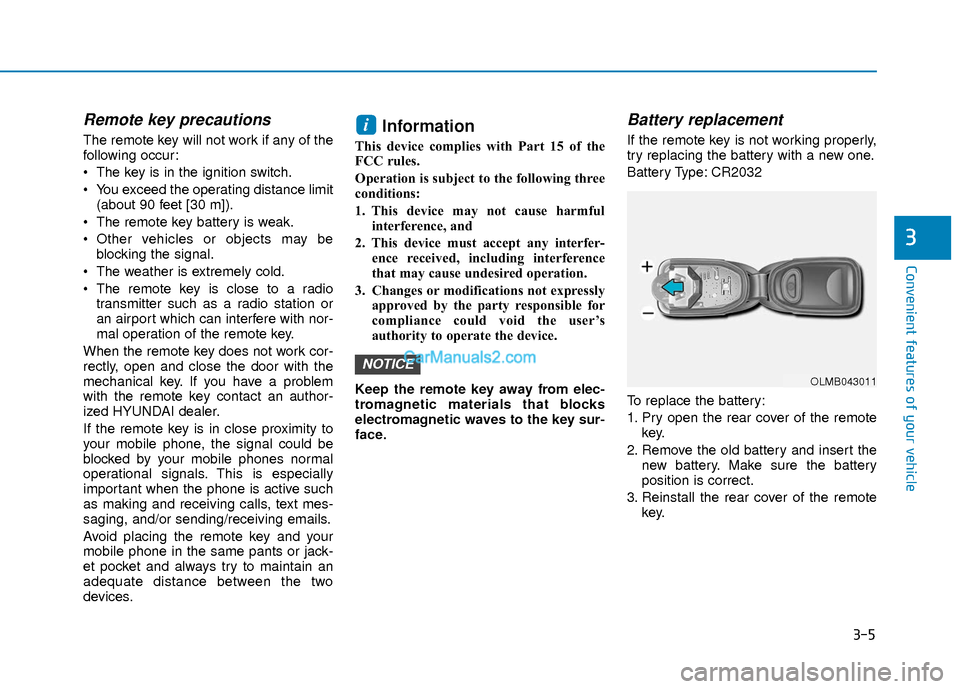
3-5
Convenient features of your vehicle
3
Remote key precautions
The remote key will not work if any of the
following occur:
The key is in the ignition switch.
You exceed the operating distance limit(about 90 feet [30 m]).
The remote key battery is weak.
Other vehicles or objects may be blocking the signal.
The weather is extremely cold.
The remote key is close to a radio transmitter such as a radio station or
an airport which can interfere with nor-
mal operation of the remote key.
When the remote key does not work cor-
rectly, open and close the door with the
mechanical key. If you have a problem
with the remote key contact an author-
ized HYUNDAI dealer.
If the remote key is in close proximity to
your mobile phone, the signal could be
blocked by your mobile phones normal
operational signals. This is especially
important when the phone is active such
as making and receiving calls, text mes-
saging, and/or sending/receiving emails.
Avoid placing the remote key and your
mobile phone in the same pants or jack-
et pocket and always try to maintain an
adequate distance between the two
devices.Information
This device complies with Part 15 of the
FCC rules.
Operation is subject to the following three
conditions:
1. This device may not cause harmful interference, and
2. This device must accept any interfer- ence received, including interference
that may cause undesired operation.
3. Changes or modifications not expressly approved by the party responsible for
compliance could void the user’s
authority to operate the device.
Keep the remote key away from elec-
tromagnetic materials that blocks
electromagnetic waves to the key sur-
face.
Battery replacement
If the remote key is not working properly,
try replacing the battery with a new one.
Battery Type: CR2032
To replace the battery:
1. Pry open the rear cover of the remote key.
2. Remove the old battery and insert the new battery. Make sure the battery
position is correct.
3. Reinstall the rear cover of the remote key.
NOTICE
i
OLMB043011